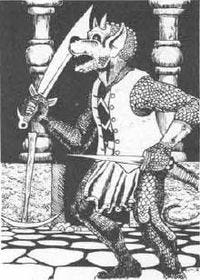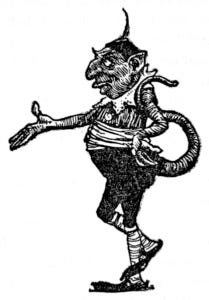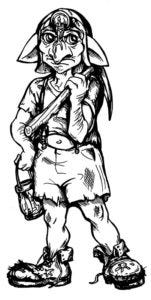Kobs, Gobs, & Cobs: Folklore as Monsters in Dungeons & Dragons
I love the glorious mess that is Dungeons & Dragons. In fact, I’m not sure it could be such a crazy stew of fun if it had been thought out ahead of time with consistent worldbuilding and mythology. Instead we have an everything-including-the-kitchen-sink approach that turned a real-world Catholic saint into a deity and a jellyfish into a floating pancake. Before there was such a thing as D&D, fantasy elements were being added to the Chainmail miniatures game to spice up traditional medieval battles. The desire for variety and surprise carried over into D&D proper, with Gygax and company shamelessly—and sometimes illegally—grabbing things from folklore, genre fiction of all stripes, and even riffing on traditional notions such as fire-breathing dragons. As a kid who got exposed to D&D and the Smurfs at roughly the same time, I was exposed to a weird and wonderful assortment of creatures without a clue or care where the ideas originated. And having played since 1982 it’s been fun to watch the game evolve and retcon its menagerie to make sense of a buffet of critters that were really only meant to populate a dungeon, challenge adventurers, and guard treasure.

Kobold in AD&D (1977) Take the humble kobold—among the first monsters any first-level D&D character will face. They are small, weak, and not too bright. Kobolds are such a huge part of tabletop gaming culture they have spawned entirely new games. (ALL HAIL KING TORG!) But their beginnings in D&D’s Monsters & Treasures booklet (Tactical Studies Rules, 1974) were humble, so much so they were described as weaker goblins—who in turn “are as described in CHAINMAIL.” My early impression of kobolds were as the schnauzers of D&D, little yapping dog-men with more confidence than ability, a notion that stayed in place until articles by Roger E. Moore and the Dragon Mountain box set solidified a concept of pygmy guerrilla warriors who use their size and nimble nature to their advantage. Later editions of D&D have retconned kobolds into reptiles, cousins to dragons.

J. D. Batten, 1895 Jump into the Wayback Machine and ask a thirteenth century German peasant about a kobold and you’d get a very different answer. It was a sprite or a spirit—a faerie creature—many believed worked as a helper in a household or sailor on a ship. Like anything long-standing in culture the descriptions change depending on time and location. They could be mischievous or temperamental but were not evil. In general they resembled tiny men with exaggerated features who wore clothes similar to the professions they hung around. Unlike the tribal adversaries of D&D, kobolds were considered helpful and benevolent. (I for one would welcome the bieresal, the kobolds who “bring beer into the house, clean the tables, and wash the bottles and glasses.”) While you’re back in time, journey across medieval Europe and see how pagan mythology got adapted after the domination of Christianity and how the folklore of spirits and faeries has general consistency but specific regional differences. “Goblin” is an English catch-all for creatures of this type, though often not as helpful as their German cousins. Closely related is the Welsh coblyn, a type of “knocker” who would make warning noises before a cave-in. But the coblyn of Wales and Cornwall has a variant, the nasty coblynau, fiendish workers who haunt caves and mines and cause trouble. I’m grateful to Gary Gygax and Dave Arneson for blazing the trail of grabbing folklore and D&D-izing it. When writing my adventure A Delve in the Cave, I quickly zoomed in on the culture, language, and folklore of medieval Wales to offer flavor to the town of Shadowhaven. And while I could have easily used kobolds or goblins from D&D in the adventure, I noted the Monster Manual (5E version) is sorely lacking fey creatures and this would be a perfect opportunity to add one.

Coblynau, Lindsay Archer Enter the 5E coblynau, described and statted in my adventure, and made open content so that anyone else publishing using the Open Game License will be able to use and adapt them however they like. I kept the “cobs” much as the folklore describes, resembling little miners with exaggerated features, adapted to darkness and stone. While not tough in a straight-up fight, their ability to scramble around and mess with the environment makes it dangerous to underestimate them. They also have the ability to manipulate shadow to help them avoid the swords and spells that inevitably come their way. I’m grateful that my long-time creative partner, Lindsay Archer, once again brought my ideas to life with a stroke of her pen. We’re running a short crowdfunding campaign to pay for the final production and printing costs of our 5E adventure, A Delve in the Cave. Click here if you’d like to learn more or check out the video below. Now if you’ll excuse me, I’m going to ask our house kobold to fetch me a beer and wash a load of dishes.
httpv://www.youtube.com/watch?v=Cmr1XQ8c1pI

